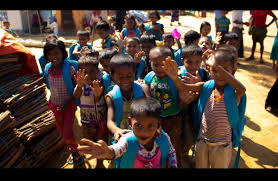Persecuted Rohingya Community Left In Lurch, As They Get No Formal Schools Or Jobs
Cox’s Bazar, Bangladesh – The Rohingya camp at Kutupalong, which is also the world’s largest refugee camp is located on the Bangladesh-Myanmar border. The refugees of Rohingya, who were pushed out from their homeland consists of all ages and gender. Women, Men and children who were uprooted from Myanmar, have to stand in long queues outside the offices of various aid organizations and wait to receive clothes, food and medicines.

The people rush to get stacks of bamboo to protect their weak settlements from the upcoming monsoon. Children to work alongside elders to carry heavy poles as they balance boxes of aid material on their little heads. Some of them run around and play in groups, while others attend temporary learning centres where languages like, English, Burmese and Mathematics are taught.
The Rohingya community faced brutal persecution and discrimination by the government for Myanmar which does not recognize them to be legal citizens and has killed or forced out large chunks of their population in repeated, barbaric acts of ethnic cleansing.

After the recent violence in August last year, more than 700,000 Rohingya had to seek refuge in Bangladesh’s Cox’s Bazar district which makes up their population up to a million as of now.
Children and youth with age mostly between 3-24 years makeup to half of the Rohingya refugees and are not permitted to pursue formal education in Bangladesh.
Temporary learning centres impart informal education and religious schools or ‘maktabs’ offer Arabic language and Quranic education.
Maktabs are not related to the network of temporary learning centres and they receive funds from private Bangladeshi donors or countries like Saudi Arabia and Turkey.
The refugees in Bangladesh camp see the maktabs as positive ones as against the religious oppression of the Rohingya in Rakhine state. Since any movement outside the camp is not allowed by the authorities, children find the maktabs a good option to keep themselves busy.
The temporary learning centres were set up by the UNICEF, Save the Children and local Bangladeshi organisations. They provide informal education to Rohingya children aged 4-14 years.
The centres do not impart Bengali as one of the languages under the current curriculum due to the fact that the Bangladesh government does not plan to integrate Rohingya refugees with the local population.
It is past noon now and the temporary learning centre installed at the camp has wound up for the day. Children move out hurriedly out of the small room made of tin, sticks, and coarse cloth.
A blackboard, with the words ‘beard’, ‘abdomen’ written in English, stands in a corner. The teacher, Mohammed Abdullah, an 18-year-old Rohingya refugee, rubs it clean.
You May Also Read: BREAKING NEWS: US, Britain And France Target Syrian ‘Chemical Weapons Sites’